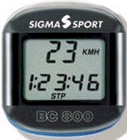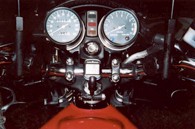

(For those who want a truly accurate speedometer) Well I got my first Sigma Sport BC800 Cycle Computer (speedometer) installed today. Actually I started on Saturday. It took me about an hour or two to hook it up. Directions are in 8 different languages. I had to find one I could understand. The wire from the sensor on the forks to the display on the handle bars was too short, so I had to extend it. Other than that, it was pretty easy. The important thing is to install the magnet/sensor as close to the axle as possible. The hard part was rigging some kind of light to it so you can read the display at night. I think I spent about 16 hours on that phase. I would install something and rip it apart because I didn't like the way it looked. Just could not find what I wanted. I finally ended up with a 3 watt light bulb, hanging out a piece of 1/2 inch copper tubing, on the end of some 12 gauge wire, all taped together. I am not crazy about it but it works very well...
The above photo shows what it looks like installed on my 1979 Kawasaki KZ400. One of these days I will learn how to use my camera. You can see it in the center of the handle bars. The little copper pipe in front of it is the light I made. It even lights up my other gauges. I have since painted it flat black so it blends in with the rest of the bike.
After working on it all weekend, I was ready for the test ride. I think the temperature was in the low 40's, but I was going anyway. The bottom line is, it works great! My trip was 22.70 miles, average speed 35.01 miles per hour, duration 38 minutes 55 seconds, maximum speed was 73.2 miles per hour. This thing is great! And very accurate! I though I might have crossed my wires (as usual) because the display said I was going NEGATIVE 35 miles per hour. Not bad, and I didn't know the Kawasaki had a reverse gear. Actually it displays a + sign if you are going faster than your average speed, a - sign if you are going slower than your average speed, and a big dot if you are going your average speed. When you install the computer you have to measure the circumference of your front tire and enter this WS (Wheel Size) into the computer. The front tire on my Kawasaki KZ400 measured 6'3" or 75 inches. This number needs to be converted to mm. So you multiply 75 inches by 25.4 constant to get mm. Mine was 1,905 mm. Next you have to convert that number to miles so you multiply the 1,905 mm by 0.621 and that gave me 1183. You key that WS value into the computer. I guess that is why it is so accurate. If you get different tires, you just measure and re-calibrate the computer. If you use kilometers you can skip the last step. It is nice when you spend money on your bike and your addition really works. The Kawasaki KZ400 is done. Now I have to start installing it on my 1970 Harley Davidson Sportster XLCH. I think I will skip the light part. I don't drive the Harley much at night.
The model I bought was the Sigma Sport BC800. I paid $22 + $5.50 shipping =
$27.50.
I bought my BC800 and BC906's at: Cherry
Creek Cyclery & More.
If you like gadgets, you will love the Sigma Sport BC800 and BC906!
I found out you don't have to spend much time getting the exact measurement of your front wheel. Anything close will get you fair results. When I measured mine and did the calculations, the answer was 1183. First I tried 1183 and ran some tests. Then, just for kicks, I added 200 to the WS and put in 1383. Now at true 60 mph, it registered 70 mph. Thus to increase 1 mph at 60 mph, you have to increase the WS you enter by at least 20. So just measure, round up and it should be fine. I rode for two months with a WS number of 1200 because I like round numbers and could not think of a better way of getting more accurate results.
I wanted to make my BC800 and BC906 as accurate as possible and I finally came up with a way to zero in the BC800 and BC906. It is so simple, I wondered why it took me two months to figure it out. Yes, I tried the "get out on the high way with stop watch in hand routine", but it is very difficult to keep a steady speed and not get run over or run into the car in front of you. So I had to find a better way to find that perfect WS number. I am assuming the BC800 and BC906 is going through the same routines to calculate MPH as it does to calculate mileage. With this theory in mind, I proceeded out on the high way and check the accuracy of the trip odometer. I wanted to get it as accurate as possible, so I looked for a long stretch of road with mileage markers. There just happens to be a 18 mile stretch of road around me that goes to the airport, so I used it. I pulled off the high way and completely stopped at mileage marker 1. There I reset the trip odometer on the BC800 and BC906 to zero. Then I drove 18 miles and pulled off the road and completely stopped at mileage marker 19 to record the BC800 and BC906's trip odometer. It was sitting right at 15.13 miles. So I knew my WS setting in the BC800 and BC906 was too small. Next I calculated what the WS setting should be using the simple formula below. Using this formula, the correct WS should be 1190. I keyed 1190 into the BC800 and BC906 and ran the same test over. This time the BC800 and BC906 was dead accurate! The trip odometer said 18.00. Now I know the BC800 and BC906 is properly set. I tried the same procedure on my Harley. I followed the BC800 and BC906 instructions and measured the tire size. This gave me a starting WS value of 1280. Running my trip odometer test and recalculation gave me a corrected WS value of 1249. That's a difference of 31 points! I think a lot of the difference has to do tire pressures, weight of the bike/riders, construction of tires and how things change at speed. So this is my advice:
True Mileage * Current WS value / BC800 and BC906 trip odometer reading = Accurate WS value
My True Mileage was 18 miles
My Current WS value was 1000
The BC800 and BC906 trip odometer reading was 15.13
18 * 1000 / 15.13 = 1189.68 (I rounded to 1190)
So the Accurate WS value is: 1190
Then you have three other choice to get the accurate WS value:
Well I just ordered my third BC800. I am going to install it in my 1985 VW Golf as the stock speedometer is not very accurate. The little light tied on to the windshield wiper lever lights up the BC800 and BC906 at night.
Important: When installing on a car, be sure to mount the sensor to the engine/transmission, not the frame.
Several people have requested a better way of setting the WS value without doing all the math, so I have created tables. All you need to do is:
Here are the tables. The more miles you go, the more accurate the WS value will be. The 2 mile run will get you in the ball park. The 8 mile run is pretty good and the 16 mile run is dead on. If you need a different table, just let me know. I hope this helps. Email me and let me know how you make out.
| WS Correction Tables | ||
|---|---|---|
| 02 Mile Chart | 08 Mile Chart | 16 Mile Chart |
Here is the standard instruction manual for the Sigma Sport BC800 and BC906 Cycle Computers.
I just discovered something interesting about the BC800 and BC906. Once the trip duration (STP) exceeds 10 hours, it resets the trip odometer and your average speed. It does not reset your maximum speed. So you can not record trips more than 10 hours long or more than about 600 miles. I got the 600 miles figuring an average speed of 60 mph for 10 hours. Here is a excellent site on the installation of your BC800 and BC906 http://www.sa750.com/BC800 and BC906/BC800 and BC906.htm
I just ordered my 4th BC800. This time I am installing it in my 1987 Pontiac Grand Am. I ordered this one from: x in Nevada. This new BC800 model allows for two wheel sizes. Because I do not change wheel sizes on my cars or motorcycles, I will use this second setting for Kmh instead of MPH. I am also thinking of using one as a tachometer. Pictures will follow soon.
Important: When installing on a car, be sure to mount the sensor to the engine/transmission, not the frame.
| Vehicle | Tire Size | WS Value |
|---|---|---|
| 1970 Harley Davidson Sportster | 3.25/85H19 | 1247 |
| 1979 Kawasaki KZ400 | 90/90-18 | 1189 |
| 1985 VW Golf | 175/70R13 | 1086 |
| 1987 Pontiac Grand Am (removed in 2011) | P195/70R14 | 1200 |
| 1980 Kawasaki KZ440 (BC906) | 3.00S18 | 1870 |
The BC800 and BC906 does not round its calculations. Thus if your true speed is 59.99 MPH, the BC800 and BC906 will truncate the numbers and report 59 MPH, not 60 MPH. Not that it makes a big difference, but I though you might want to know.
I received a gift for donating blood to the American Red Cross. I got to pick from a list. I picked the Sigma BC906. I mounted in on my 1980 KZ440. It is very similar to the BC800, but it is a little different with the control buttons. I will get some pictures soon. So now I have 5 cycle computers. I also pulled the one on my 1987 Pontiac Grand Am. The odometer on that car went to 199,999 miles and stopped. But the speedometer still works. I pulled the BC800 because I will be soon getting rid of the car soon, so I wanted to pull things I wanted to keep. I am thinking about mounting it on my 2001 Kawasaki ZR-7S.